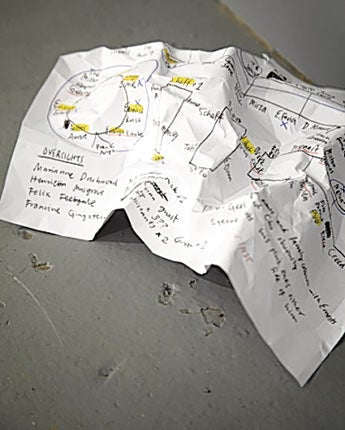Ryan Gander: Locked Room Scenario, Londonewcastle Depot, London

It was amazing, but you missed it: the legendary gig, the party, the good, sexy part of the Sixties, the Salon des Refusés, fluxus, punk, the first performance of Stravinsky and the Ballet Russes' The Rite of Spring, the first exhibition of Duchamp's fountain. Also, other things you might have missed – the chance to say goodbye, to apologise, to have a love affair, to be there on that night that everybody still laughs about now. It's in this gulf of missed or denied opportunities that Ryan Gander pitches his latest, elusive, project produced by Artangel.
Locked Room Scenario, staged in a warehouse in Hoxton, centres on an exhibition in the central space that one can't enter. Without spoiling the experience, which is one that relies on surprise and intrigue, one can piece together some kind of story from the surrounding extraneous rooms. What might have been a resource room for the exhibition features a timeline of a fictitious artistic group, active around the 1970s, who made work that was described at some point as "Blue Conceptualism", a phrase that rather well describes the work of Gander himself.
Some postcards are on a rack nearby featuring the group's work that are nearly hilarious in their melancholic tone – a bleached-out image based on the photograph of a nude Lee Miller in Hitler's bathtub is named It Cries Itself to Sleep (1973) by an artist called Spencer Anthony. A big blue sculpture made of fluffy blue fur has a cardboard sign around its neck like a homeless person that reads "If I was in monochrome I would be better appreciated".
We glimpse fragments of the exhibition itself through the windows, alongside other mysterious materials. Scrawled notes and graffiti – circled notices in newspapers, a gallery office, a seating plan, presumably for a dinner following the opening. There are strange people in the building, too, and outside. Who is acting? Who is not? It's undoubtedly intriguing, if you like puzzles and stories, and it's not insignificant that crosswords, codes and hidden messages play a significant part in this exhibition. Fun, yes, but melancholic, too. This narrative seems to be one of missed opportunities – misunderstandings – notes left, things unsaid.
Artangel has a rather proud history of public projects in Britain – think Rachel Whiteread's House (1993), the artist's concrete cast of the interior of a condemned terraced house in Bow, or, more recently, Roger Hiorns' Seizure (2009) another dank, abandoned apartment, this time filled with azure blue copper sulphate crystals. I wonder if this project in particular is more highly focused on the peculiarities of the artworld – with its fascination with restaging past moments and fetishising past movements – than those projects just mentioned. As an exercise in staging the unreachable artistic moment from history, however, it throws up some interesting questions. It occurs to me how easy it is to make something look like "art", and the curious mixture of longing and frustration that artists feel for certain moments in art history, as though what happened then could never happen now. They're right, we've always come too far along. We just missed it.
To 23 October (020 7713 1400)
Join our commenting forum
Join thought-provoking conversations, follow other Independent readers and see their replies
Comments